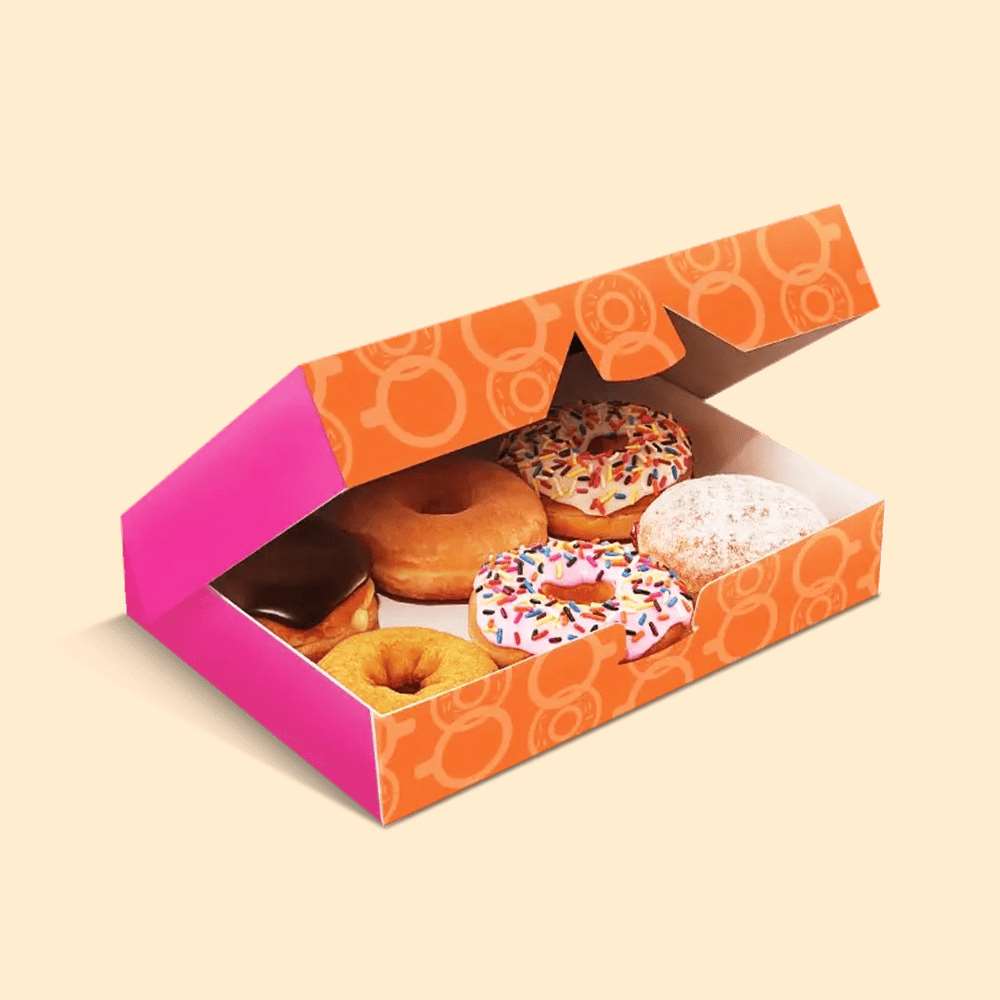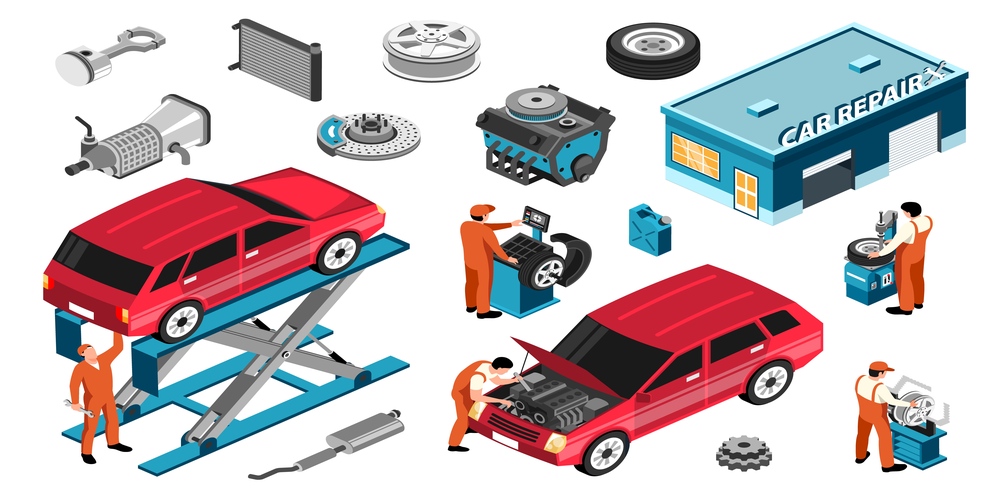There’s more to kitchen utensils than meets the eye. Seeing a pile of nearly identical spoons in your cutlery drawer may seem silly and excessive, but kitchen utensils are specifically designed to tackle certain tasks in the most efficient way possible.
These spoons are carefully constructed with special materials to do one task perfectly—and the rest of your kitchen utensils have been crafted with the same intention and care.
What Are Kitchen Utensils?
Just because the world of cookware is oh so large and ever-expanding, we thought we’d show you the recipe for a successful working kitchen. kitchen utensils in Pakistan are small handheld tools used in the kitchen for food preparation. The word utensil comes from the Latin word, utensilia, which translates to “things for use;” a pencil is a writing utensil, a spatula is a cooking utensil, etc.
With literally hundreds of kitchen utensils on the market, it can be hard to figure out what you really need and what you can easily do without. That’s where we come in, and we’re here to help.
As much fun as it would be to go on a major shopping spree and buy every cooking gadget we see in Better Homes and Gardens, let’s be realistic for a second. We can’t afford that, and we certainly don’t have space for it. So, let’s get down to the basics of needing the basics.
Kitchen Utensils You Should Have
Whether you’re hosting a dinner party for a large group of friends (are we invited?) or looking to treat yourself to a well-deserved meal, these are the utensils you absolutely need.
Knives
There are several types of kitchen knives, and we’re going to give you the run-down on the ones every kitchen should have.
Chef’s Knife
A chef’s knife earned its name for a reason – no chef would be caught dead without one. This knife is one you wouldn’t want to run afoul on. Clocking in at eight to ten inches long and around one inch thick, with a rounded tip, it’s the largest knife usually found in your classic knife block. A chef’s knife is slices, dices, and chops larger foods; veggies, herbs, and a variety of meats are perfect for this blade.
Santoku Knife
A santoku knife looks very similar to a chef’s knife, but a few important distinctions will affect and optimize your final result. Santoku knives are usually five to eight inches long, feature a wide sheepsfoot blade (a straight cutting edge with an unsharpened curved back spine) with no tip, and are lighter to hold than a chef’s knife. These knives also tend to have a thinner blade which allows for more refined slicing, ideal for handling smaller ingredients such as slicing cheese, chopping nuts, and mincing herbs.
Bread Knife
Bread knives are long ones and have serrated edges, much like the teeth of the ferocious Tiger Shark. If you had to guess the purpose of the bread knife, we’re pretty sure you’d get it on the first try. Bread often crumbles or tragically flattens when cut with other knives. For the perfect sandwich, you’d be the laughing stock of Iron Chef if you even tried to use another knife on a lovely brioche. In fact, that might be an actual crime. Remember, this knife cuts a little differently than its peers. Make sure to use a sawing motion when slicing to ensure that all bread looks as beautiful as it deserves to.
Read More About: women undergarments.
Paring Knife
If Disney movies have taught us anything, it’s to never underestimate the little guy. This small knife can handle pretty much anything you throw at it. Need a sliver of lime to go with that beer? Need to dice some herbs to sprinkle on a buttery pasta? Don’t worry; the paring knife has you covered. A paring knife is a must-have for cutting those easily-bruised avocados, BTW. So, go ahead and post that avocado toast on Instagram. It looks perfect.
There are a few more knives – steak knife, boning knife, carving knife, and serrated knife, to name a few – that we could go over, but with at least these four in your cutlery drawer, you should be good to go!
Spoons and Ladles
Now that the “sharps” category is taken care of, let’s turn to the round, smoother kitchen tools.
Standard Kitchen Spoon
A standard kitchen spoon is likely one of the only utensils every kitchen has; if a kitchen is standard-spoon-free, there’s something fishy going on. This spoon is oversized and usually wooden but will also be available in metal, like copper. (A wooden spoon is heat-resistant, durable, dishwasher safe, and won’t leave scratch marks on your cookware.). This spoon is another multi-purpose utensil but is best suited for working with food and liquids and stirring big pots.
The standard kitchen spoon comes in two forms: solid and slotted. The solid version looks just like a regular spoon and helps stir big mixtures. A slotted spoon has any variation of slots, holes, or openings that allow for liquid drainage to preserve larger solids on top (like pasta).
Spatula
There are several variations of spatulas, but generally, a spatula is broad, flat, and semi-flexible and used to mix, spread, and lift ingredients. #Learningmoment: the word spatula comes from the Latin word spatha, which roughly translates to “broadsword.” Spatulas are excellent tools for scraping the edges of a mixing bowl, leveling off dry mixing cups, spreading icing, and more.
While the handle of spatulas varies in material (but often uses wood to insulate them from heat), the “head” or blade is usually made of metal or plastic. Spatulas will usually come as a set of two with one smaller and one larger, designed to tackle different tasks. Larger spatulas will be better for sliding under food to pick it up or flip it (hello, pancakes and eggs), while smaller spatulas will be helpful for poking around in small pans.
Soup Ladle
A ladle is a long-handled spoon designed with a big, cup-like spoon basin at the end. A quality soup ladle will have a hook or curve at the end of the handle to prevent it from falling into the pot while cooking. Variations of ladles may include a point on one side of the basin, allowing for a finer stream when pouring (this feature makes pouring things like soup much easier). A soup ladle will come in very handy for things like soup, stew, punch bowls, and pancake mixture.
Pasta Ladle
Any pasta lovers out there? Join the club. A pasta ladle is similar to a soup ladle with the difference of having edged teeth around the rim and a hole in the middle of the basin. The edged teeth help the ladle grip onto noodle-y pasta, and the hole allows the water to drain out; the result is pasta without the mess that can be served straight from the main cooking pot. Ugh, stop already: now we’re hungry!
Measuring Spoons
Measuring spoons are the little family unit of your kitchen. They usually come in a pack and can help you scoop spices and other necessities in usual amounts of 1/8teaspoon, 1/4teaspoon, 1/2teaspoon, 3/4teaspoon, one teaspoon, and one tablespoon. While some of these are just too precious for words (hello, cutesy matching sets!), make sure you are buying quality food-grade stainless steel. Staining and rusting? Yeah, that doesn’t exactly get our appetites going. We’re partial to engraved sets that feature both American and metric measurements, meaning they’ll never rub off, and you can get familiar with the other system (why not expand your knowledge?).
A Cookware Set
The world of “cookware” covers a range of utensils for cooking food. While you probably don’t need all the pots and pans under the sun, the essentials your kitchen needs are a Fry Pan, Sauce Pan, Dutch Oven, and Sauté Pan.
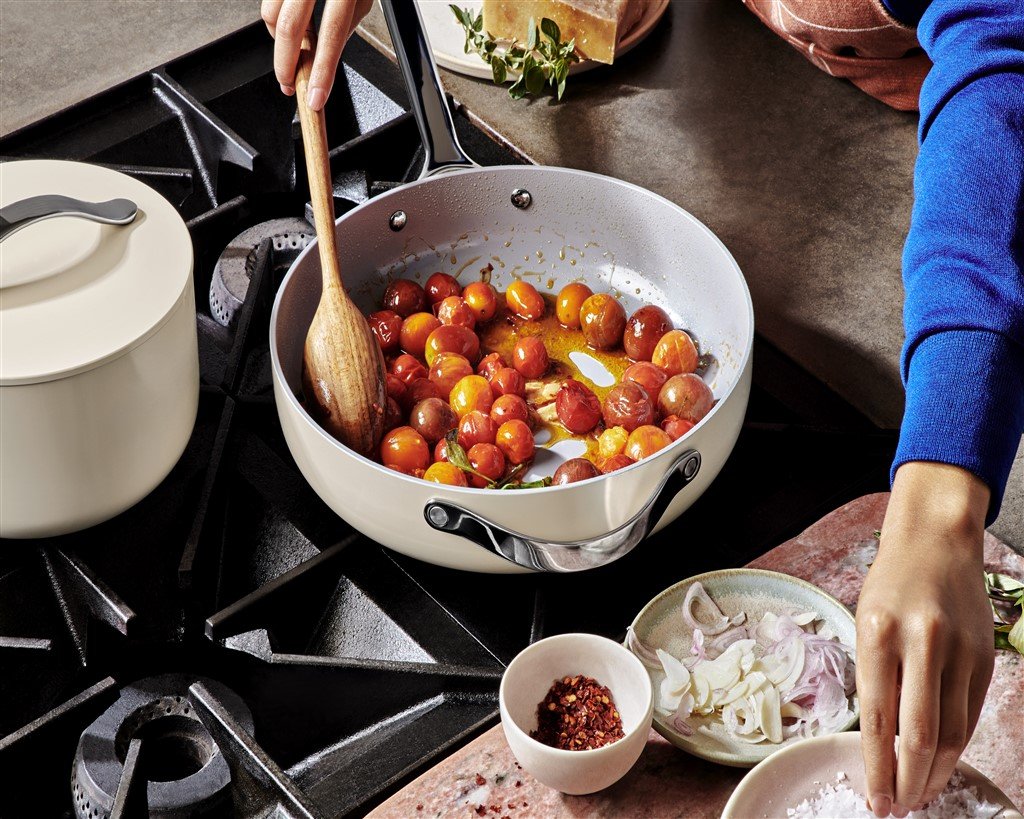
Sauté Pan
The wheel, the theory of relativity, sliced bread, the Sauté Pan—these are history’s greatest inventions. We may be exaggerating just a tad, but once you bring a Sauté Pan into your kitchen, you won’t know how you used to function without one. Sauté Pans are designed to cook a large amount of ingredients without overcrowding, using its high edges and a wide base to seamlessly toss ingredients without spills.
Sauté Pans are the most versatile cookware money can buy. A Sauté Pan is ideal for saucy dishes like curries and casseroles, and its conductive abilities make it a wonderful option for braising meat or frying vegetables. With a Sauté Pan, you can whip up a perfectly-portioned one-pan meal or make food en masse when entertaining. Best of all, Sauté Pans add a delightful pop of color to any kitchen—and they’re a joy to clean. So if you could only bring one cookware item to a desert island, make it the Sauté Pan.
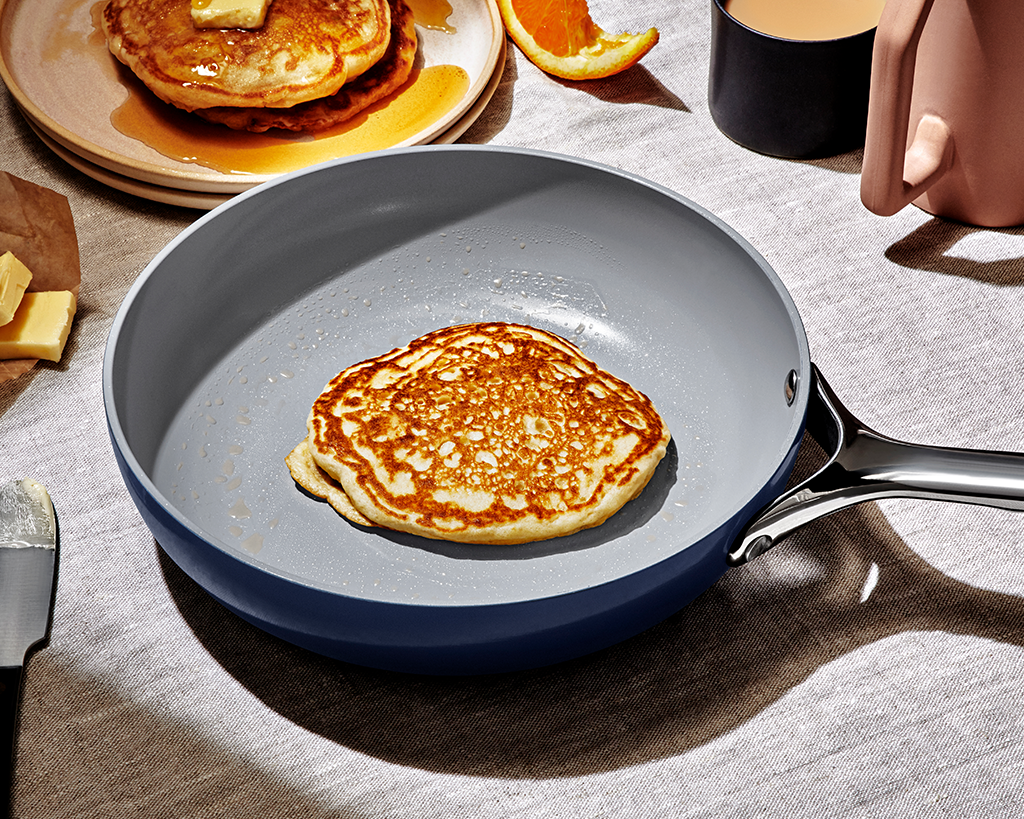
Fry Pan
If someone asks you to picture a pan, you’re probably thinking of a Fry Pan. This iconic, flat-bottomed pan with a graceful bowl-like rim is perfect for cooking up all your favorites: pancakes, vegetables, a nice omelet. We believe in working smarter, not harder, so a non-stick Fry Pan is the only way to go.
A special note to all the foodies out there: you know how careful you are about using only the best ingredients? Well, you might not be eating as clean as you think you are. The FDA is conducting research on a group of chemicals called PFAS (a group of human-made chemical ingredients in 95%+ of non-stick cookware). The chemicals in the pan leaches from your pot right into the food that you literally just picked up from the Farmer’s Market. Most of this leaching happens when temperatures hit 500° Fahrenheit in your pan (after just two minutes of usage!). This Fry Pan, however, is 100% non-toxic, made with all natural non-stick ceramic. Plus, it’s safe for temperatures up to 550° Fahrenheit.

Sauce Pan
A Sauce Pan is what you need for cooking dishes like risotto, mac and cheese, soups, and sauces. A Sauce Pan is essentially the castle of cookware. Small bases, higher sides equals plenty of room to keep yummy stuff contained when the food really gets to flying.
When cooking liquid-based dishes or boiling water, a Sauce Pan is your first line of defense against sauce getting everywhere. Your kitchen needs a high-quality non-stick and non-toxic ceramic product that holds strong up to 550° Fahrenheit. Transferring mac and cheese from a pot to a dish to get that delicious bread crumb broil going on? Not needed. Get you a Sauce Pan that can do both, like this one.
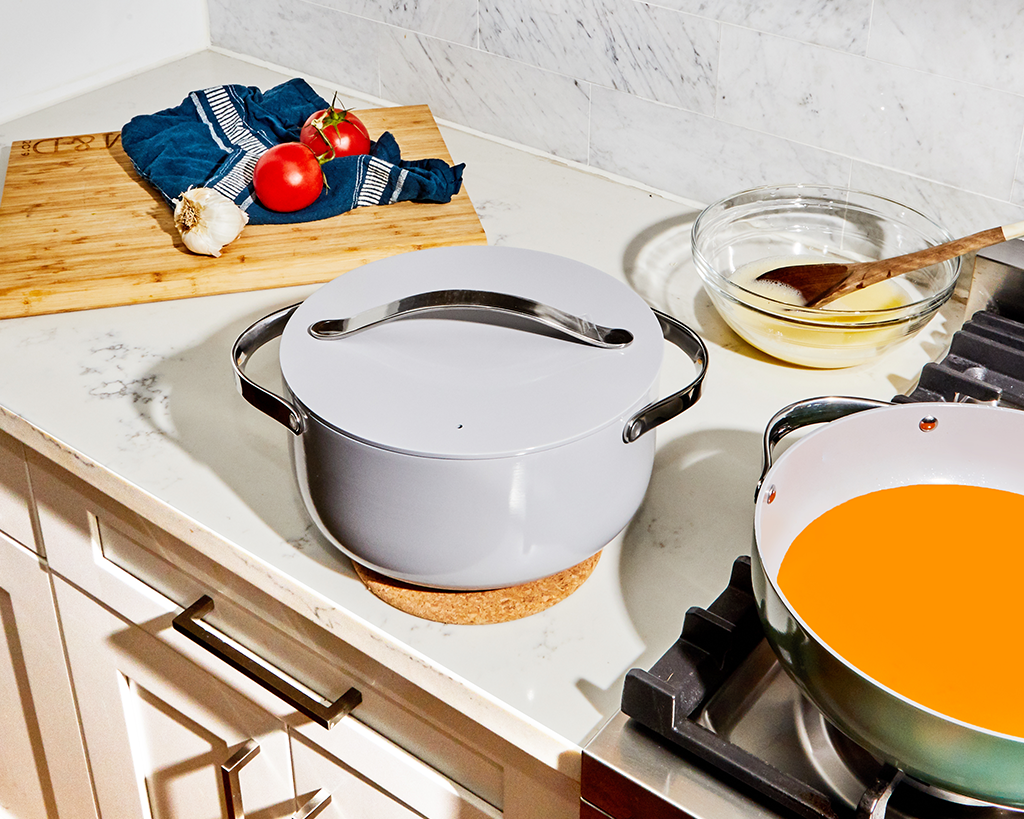
Dutch Oven
Some actors are known as triple threats. If we had to apply that terminology to cookware, it would definitely be the Dutch Oven that earns the moniker. This pot can do pretty much anything. This handy tool has super higher sides than our previously mentioned pans and conquers the kitchen Olympics by searing, cooking, and so much more. The pot is a lifesaver for one-pot meals, enabling all the goodness of cooking with not so much of the clean-up afterward. Again, look for one free of toxic materials, preferably with a slick non-ceramic coating allowing for the use of less oil or butter when cooking.


